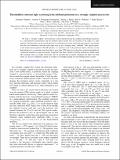| dc.contributor.author | Williams, Benjamin S. | |
| dc.contributor.author | Hu, Qing | |
| dc.contributor.author | Gambari, Johannes | |
| dc.contributor.author | Fernandez-Dominguez, Antonio I. | |
| dc.contributor.author | Maier, Stefan A. | |
| dc.contributor.author | Kumar, Sushil | |
| dc.contributor.author | Reno, John L. | |
| dc.contributor.author | Phillips, Chris C. | |
| dc.date.accessioned | 2011-01-28T20:10:46Z | |
| dc.date.available | 2011-01-28T20:10:46Z | |
| dc.date.issued | 2010-09 | |
| dc.date.submitted | 2010-07 | |
| dc.identifier.issn | 1098-0121 | |
| dc.identifier.issn | 1550-235X | |
| dc.identifier.uri | http://hdl.handle.net/1721.1/60858 | |
| dc.description.abstract | We study a “strongly coupled” (SC) polariton system formed between the atomlike intersubband transitions in a semiconductor nanostructure and the terahertz optical modes that are localized at the edges of a gold aperture. The polaritons can be excited optically, by incoherent excitation with band-gap radiation, and we find that they also coherently scatter the same input laser, to give strikingly sharp “sideband” (SB) spectral peaks, in the backscattered spectrum. The SB intensity is a sensitive track of the polariton density and they can be detected down to a quantum noise floor that is more than 2500 times lower than the excitation thresholds of comparable quantum cascade laser diodes. Compared with other coherent scattering mechanisms, higher-order SB scattering events are readily observable, and we speculate that if suitably optimized, the effect may find utility in a passive component capable of all-optical wavelength shifting for telecommunications systems. | en_US |
| dc.description.sponsorship | Engineering and Physical Sciences Research Council | en_US |
| dc.description.sponsorship | United States. Air Force Office of Scientific Research | en_US |
| dc.language.iso | en_US | |
| dc.publisher | American Physical Society | en_US |
| dc.relation.isversionof | http://dx.doi.org/10.1103/PhysRevB.82.121303 | en_US |
| dc.rights | Article is made available in accordance with the publisher's policy and may be subject to US copyright law. Please refer to the publisher's site for terms of use. | en_US |
| dc.source | APS | en_US |
| dc.title | Thresholdless coherent light scattering from subband polaritons in a strongly coupled microcavity | en_US |
| dc.type | Article | en_US |
| dc.identifier.citation | Gambari, Johannes et al. “Thresholdless coherent light scattering from subband polaritons in a strongly coupled microcavity.” Physical Review B 82.12 (2010): 121303. © 2010 The American Physical Society. | en_US |
| dc.contributor.department | Massachusetts Institute of Technology. Department of Electrical Engineering and Computer Science | en_US |
| dc.contributor.department | Massachusetts Institute of Technology. Research Laboratory of Electronics | en_US |
| dc.contributor.approver | Hu, Qing | |
| dc.contributor.mitauthor | Williams, Benjamin S. | |
| dc.contributor.mitauthor | Hu, Qing | |
| dc.contributor.mitauthor | Kumar, Sushil | |
| dc.relation.journal | Physical Review B | en_US |
| dc.eprint.version | Final published version | en_US |
| dc.type.uri | http://purl.org/eprint/type/JournalArticle | en_US |
| eprint.status | http://purl.org/eprint/status/PeerReviewed | en_US |
| dspace.orderedauthors | Gambari, Johannes; Fernandez-Dominguez, Antonio; Maier, Stefan; Williams, Ben; Kumar, Sushil; Reno, John; Hu, Qing; Phillips, Chris | en |
| dc.identifier.orcid | https://orcid.org/0000-0003-1982-4053 | |
| mit.license | PUBLISHER_POLICY | en_US |
| mit.metadata.status | Complete | |
